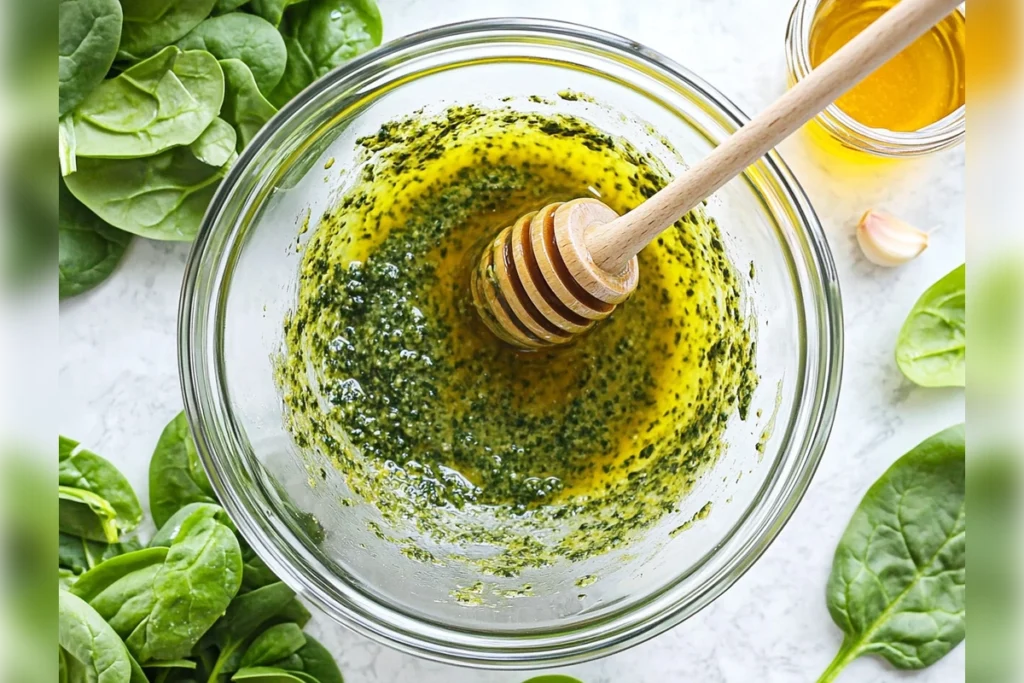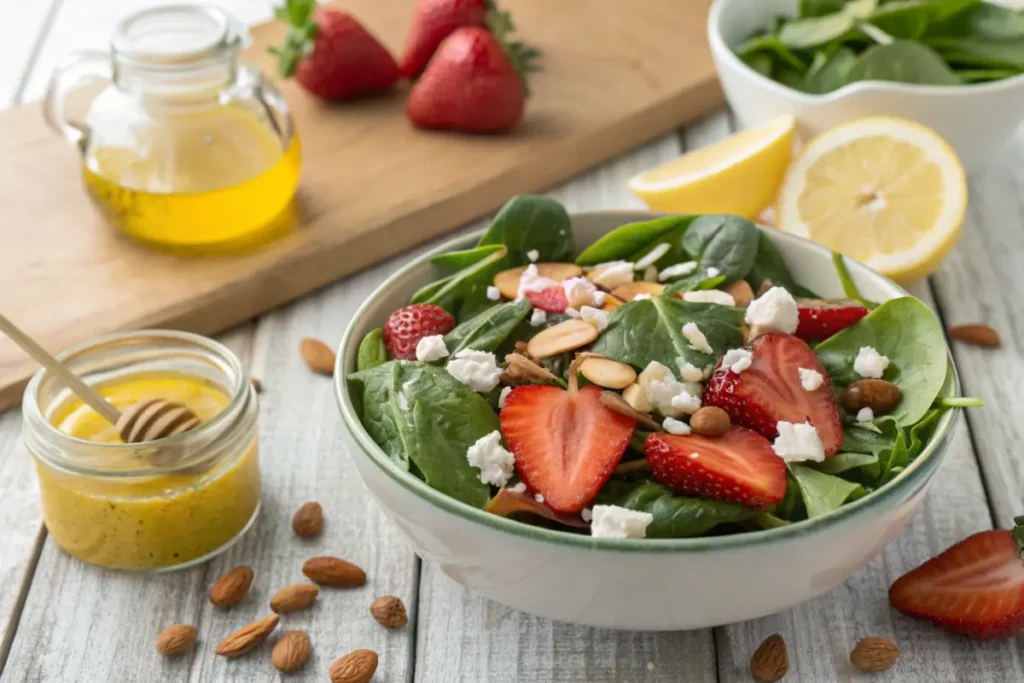Introduction to Spinach Salad Dressing
Spinach salad dressing isn’t just another sauce it’s the soul of your salad. It brings together flavors, adds richness, and ties every ingredient into a harmonious bite. But what makes a spinach salad dressing stand out from the rest? Let’s explore.
Why Spinach Salad Dressing is a Must-Try
A spinach salad dressing isn’t just about taste it’s about balance. The dressing enhances the natural earthy flavor of spinach while complementing toppings like nuts, fruits, and proteins. Whether it’s a simple vinaigrette or a creamy dressing, it creates a flavorful dance on your taste buds.
Beyond taste, spinach salad dressings are incredibly versatile. You can pair them with fresh strawberries, goat cheese, toasted nuts, or grilled chicken. The possibilities are endless!
Health Benefits of Spinach Salad and Dressing
When paired with the right dressing, spinach becomes a nutritional powerhouse. Spinach is packed with iron, vitamins A, C, and K, and antioxidants. The addition of healthy oils, vinegars, and natural sweeteners in the dressing boosts nutrient absorption and adds healthy fats to your meal.
For example:
- Olive oil provides heart-healthy fats.
- Vinegar aids in digestion.
- Mustard offers antioxidants and anti-inflammatory properties.
Simply put, a good spinach salad dressing doesn’t just make your salad taste great it turns it into a nutritional superstar.
Overview of Classic vs. Modern Spinach Salad Dressings
Classic spinach salad dressings often feature simple ingredients like olive oil, vinegar, mustard, and a touch of sweetness from honey or sugar. These recipes have stood the test of time for their simplicity and flavor balance.
On the other hand, modern variations experiment with yogurt bases, exotic spices, balsamic reductions, or even fruit purees. They bring a creative twist to traditional recipes while offering diverse flavor profiles.
Whether you lean towards classic or contemporary, one thing is clear: a well-made spinach salad dressing recipe can be the secret weapon of your kitchen.
Key Ingredients for the Perfect Spinach Salad Dressing
Creating an exceptional spinach salad dressing recipe starts with understanding your ingredients. Each component plays a specific role, and balancing them is the secret to achieving a dressing that’s both flavorful and harmonious.
Essential Ingredients Explained
Every spinach salad dressing recipe revolves around a few core ingredients:
- Oil: The base of most dressings, oils like olive, avocado, or canola provide richness and smooth texture.
- Vinegar: White vinegar, apple cider vinegar, or balsamic vinegar adds tanginess and balances the oil.
- Sweetener: Ingredients like sugar, honey, or maple syrup enhance flavors and counteract acidity.
- Mustard: Prepared mustard or Dijon mustard not only adds a spicy kick but also helps emulsify the dressing.
- Onions or Garlic: These ingredients contribute sharp, aromatic notes to your dressing.
When combined correctly, these ingredients create a spinach salad dressing recipe that’s both classic and timeless.
Choosing the Right Oil and Vinegar
Oil and vinegar form the backbone of most spinach salad dressing recipes. But not all oils or vinegars are created equal:
- Olive Oil: Ideal for classic vinaigrettes, olive oil adds a smooth and slightly fruity flavor.
- Canola Oil: Neutral in taste, it’s perfect for letting other flavors shine.
- White Vinegar: Provides a sharp tang, excellent for bright, crisp dressings.
- Balsamic Vinegar: Adds a slightly sweet and complex flavor, perfect for modern variations.
Natural Sweeteners: Honey vs. Sugar
Sweeteners are often overlooked, but they play a crucial role in balancing acidity.
- Honey: A natural option that adds floral notes and viscosity.
- Granulated Sugar: A classic choice, offering a clean, straightforward sweetness.
Using honey instead of sugar can create a healthier spinach salad dressing recipe without sacrificing flavor.
Mustard and Other Flavor Enhancers
Mustard does more than just add spice it helps emulsify the oil and vinegar. Dijon mustard, in particular, is known for its refined taste and excellent blending properties.
For an extra flavor boost, consider adding:
- Fresh Herbs: Basil, thyme, or parsley.
- Citrus Zest: Lemon or lime zest can brighten your dressing.
- Seasonings: Salt, black pepper, or a pinch of paprika.
For more inspiration, you might enjoy pairing your spinach salad dressing with a refreshing salad from this beet and feta salad recipe.
Step-by-Step Guide to Making Spinach Salad Dressing

Now that you understand the essential ingredients, let’s dive into the preparation process. Making a spinach salad dressing recipe from scratch is both quick and rewarding.
Preparation Techniques for Key Ingredients
Proper preparation is crucial for a smooth dressing. Start by:
- Mincing Onions or Garlic: Use a sharp knife for fine mincing to avoid overpowering chunks in your dressing.
- Measuring Ingredients Accurately: Precision ensures balance in flavor.
If you’re using honey, slightly warm it to make mixing easier.
Whisking and Emulsifying Your Dressing
Emulsification is the magic that holds your dressing together.
- Combine all ingredients in a large mixing bowl.
- Use a whisk to vigorously mix oil, vinegar, mustard, and seasonings.
- Alternatively, place ingredients in a mason jar, seal tightly, and shake until well-blended.
For a pro tip, let the dressing sit in the refrigerator for at least 30 minutes before serving. This allows the flavors to meld together beautifully.
Quick Tips for Achieving Perfect Consistency
- Use a mason jar for easy mixing and storage.
- Add oil gradually while whisking to ensure proper emulsification.
- If your dressing feels too thick, add a teaspoon of water or lemon juice.
A properly emulsified spinach salad dressing recipe should coat the back of a spoon smoothly.
How Long to Chill Before Serving
Chilling your dressing is essential for flavor development.
- For best results, let the dressing chill in the refrigerator for at least 1-2 hours.
- If you’re short on time, 30 minutes can still make a noticeable difference.
Your spinach salad dressing is now ready to be drizzled over your favorite salad. For a creative serving suggestion, you might also enjoy pairing it with this Napa cabbage salad.
Variations of Spinach Salad Dressing Recipe
No two salads are the same, and neither should their dressings be! The beauty of a spinach salad dressing recipe lies in its adaptability. Whether you love classic vinaigrettes or prefer creamy, yogurt-based dressings, there’s a recipe for every palate. Let’s explore some delicious variations.
Classic Vinaigrette Spinach Salad Dressing
A classic vinaigrette is a timeless choice. It’s light, tangy, and effortlessly enhances fresh spinach leaves.
- Key Ingredients: Olive oil, white or red wine vinegar, mustard, and a touch of honey or sugar.
- Flavor Tip: Add a pinch of fresh herbs like thyme or basil for extra aroma.
This dressing pairs wonderfully with a spinach salad featuring strawberries, toasted almonds, and feta cheese. It’s simplicity at its finest!
For an equally refreshing salad idea, you might enjoy our Beet Feta Salad Recipe.
Honey Mustard Spinach Salad Dressing
If you love a slightly sweet and tangy twist, honey mustard dressing is a must-try.
- Key Ingredients: Dijon mustard, honey, olive oil, and apple cider vinegar.
- Flavor Tip: Use whole-grain mustard for an added layer of texture and depth.
This dressing works perfectly with a spinach salad topped with grilled chicken, walnuts, and sliced apples. It’s both satisfying and flavorful.
Creamy Yogurt-Based Spinach Salad Dressing
For a richer texture, creamy yogurt-based dressings are the way to go.
- Key Ingredients: Greek yogurt, lemon juice, olive oil, garlic, and herbs.
- Flavor Tip: Add fresh dill or parsley for a refreshing touch.
This variation complements warm spinach salads or those with roasted vegetables like sweet potatoes and bell peppers.
Balsamic Spinach Salad Dressing
Balsamic dressing adds a hint of sweetness and a deep, complex flavor profile.
- Key Ingredients: Balsamic vinegar, olive oil, honey, and a dash of black pepper.
- Flavor Tip: Reduce the balsamic vinegar in a saucepan for a syrup-like consistency.
Pair this dressing with spinach, cherry tomatoes, mozzarella cheese, and croutons for a satisfying experience.
For more creative dressing ideas, check out our Artichoke Parmesan Tilapia Recipe for inspiration on flavor pairings.
Pairing Spinach Salad Dressing Recipe with Different Salads

A spinach salad dressing recipe isn’t just about the dressing it’s about how well it complements your salad ingredients. Let’s dive into some creative pairings that make spinach salads irresistible.
Spinach Salad with Strawberries and Almonds
This salad is a perfect blend of sweet and savory.
- Ingredients: Fresh spinach, sliced strawberries, toasted almonds, and feta cheese.
- Dressing Pairing: A honey mustard or classic vinaigrette dressing balances the sweetness of strawberries and the nuttiness of almonds.
The result? A light yet flavorful salad perfect for brunch or a summer picnic.
Spinach Salad with Grilled Chicken
Grilled chicken adds protein and heartiness to your spinach salad.
- Ingredients: Grilled chicken breast, baby spinach, cherry tomatoes, and crumbled goat cheese.
- Dressing Pairing: A creamy yogurt-based dressing adds richness and ties everything together beautifully.
This pairing works wonders for a balanced lunch or post-workout meal.
Warm Spinach Salad with Roasted Sweet Potatoes
Warm salads offer a unique texture and taste.
- Ingredients: Roasted sweet potatoes, baby spinach, cranberries, and pecans.
- Dressing Pairing: A balsamic dressing enhances the earthy sweetness of the potatoes and the tang of cranberries.
This dish is ideal for cooler seasons or cozy dinners.
Spinach Salad with Goat Cheese and Walnuts
This combination is classic and never disappoints.
- Ingredients: Baby spinach, crumbled goat cheese, candied walnuts, and dried cranberries.
- Dressing Pairing: A classic vinaigrette or honey mustard dressing balances the creaminess of the goat cheese and the crunch of the walnuts.
This salad shines as a side dish or a light appetizer.
For more salad inspiration, you might love our Napa Cabbage Salad with Ramen Noodles, another versatile recipe worth trying.
Tips and Tricks for the Best Spinach Salad Dressing Recipe
Creating the perfect spinach salad dressing recipe doesn’t have to be a challenge. With a few helpful tips and tricks, you can elevate your homemade dressing to restaurant quality. Whether you’re a beginner or an experienced home cook, these insights will ensure your dressing turns out flavorful and well-balanced every time.
Expert Advice for Flavor Balance
Balance is key in any spinach salad dressing recipe. Too much acidity can overpower the greens, while too much sweetness can make the dressing cloying. Here’s how to achieve the perfect harmony:
- Start Small: Add vinegar or lemon juice gradually to avoid an overly sharp taste.
- Sweeten with Care: Use honey or sugar sparingly, adding more if needed after tasting.
- Taste as You Go: Always taste your dressing before serving. Adjust salt, pepper, and seasonings as needed.
A simple trick is to dip a spinach leaf into the dressing while tasting it gives a better sense of how the flavors will blend in the final salad.
Common Mistakes to Avoid
Even the best cooks can make mistakes, but knowing what to watch for can save your dressing.
- Over-Whisking: Over-mixing can break the emulsion, causing the dressing to separate.
- Using Poor-Quality Oil: The oil is the backbone of any spinach salad dressing recipe, so always choose a high-quality option.
- Skipping Chill Time: Allowing your dressing to sit in the fridge for at least 30 minutes enhances its flavor.
If you follow these tips, your dressing will not only taste delicious but also look appealing on your salad.
How to Store and Reuse Dressing Properly
Storing your spinach salad dressing correctly can extend its shelf life and keep flavors fresh.
- Use an Airtight Container: Store dressing in a glass mason jar or a sealed bottle.
- Keep It Cool: Always refrigerate your dressing after preparation.
- Shake Before Use: Oils and vinegars tend to separate over time. Give the container a good shake before serving.
Most homemade dressings stay fresh in the fridge for up to one week. If you notice any unusual smell or change in texture, it’s best to discard it and make a fresh batch.
For more culinary inspiration, you might enjoy this hearty Warm Spinach Salad with Roasted Sweet Potatoes.
Frequently Asked Questions (FAQ) About Spinach Salad Dressing Recipe
When it comes to making a spinach salad dressing recipe, a few common questions often pop up. Below, we’ve addressed some of the most frequently asked ones to help you master the art of salad dressings.
What is the healthiest dressing for salad?
The healthiest salad dressings are typically vinaigrettes made with olive oil and vinegar. These dressings are low in saturated fat and full of heart-healthy fats. A homemade spinach salad dressing recipe using olive oil, lemon juice, and herbs is an excellent choice for health-conscious eaters.
What are the ingredients for spinach salad?
A classic spinach salad usually includes fresh baby spinach leaves, sliced red onions, hard-boiled eggs, bacon bits, cherry tomatoes, and sometimes fresh fruit like strawberries. The dressing brings all these ingredients together and adds flavor.
How to make salad dressing like Jamie Oliver?
Jamie Oliver’s salad dressing recipes often focus on simplicity and fresh ingredients. Typically, he uses a mix of extra virgin olive oil, vinegar (like balsamic or red wine vinegar), Dijon mustard, and a pinch of salt and pepper. Whisk everything together, and you’ve got a dressing ready for your spinach salad.
What is the most popular salad dressing?
Ranch dressing remains one of the most popular salad dressings in many regions. However, vinaigrettes, Caesar, and balsamic dressings are also favorites. For spinach salads, vinaigrettes and honey mustard dressings are often preferred because they complement the leafy greens beautifully.
Can spinach salad dressing be made in advance?
Absolutely! In fact, most dressings taste even better when made in advance. Prepare your spinach salad dressing recipe, store it in an airtight container, and let it sit in the fridge for a few hours or overnight for the best results.
For more culinary ideas and recipes, don’t miss our Artichoke Parmesan Tilapia Recipe.




2 thoughts on “The Ultimate Spinach Salad Dressing Recipe: Easy & Delicious Variations”